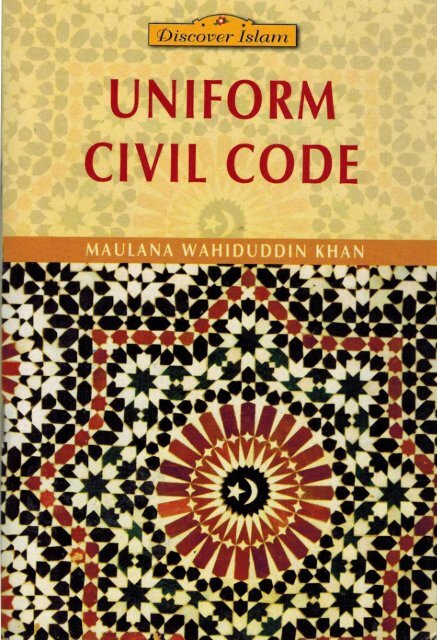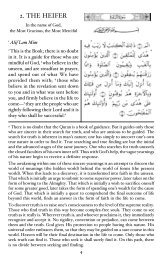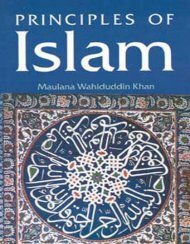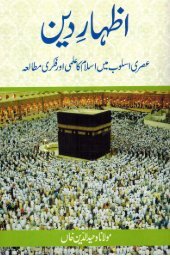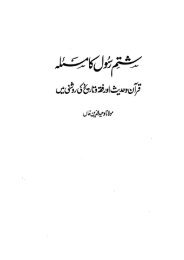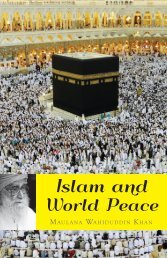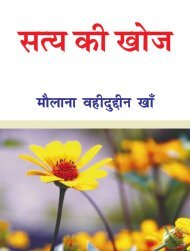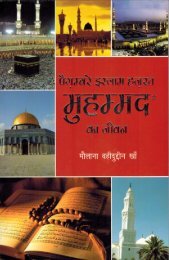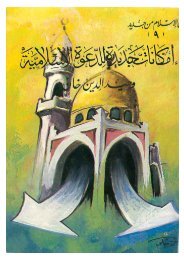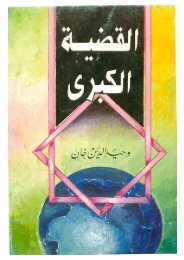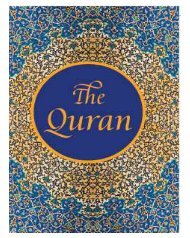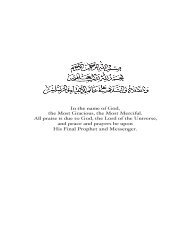Create successful ePaper yourself
Turn your PDF publications into a flip-book with our unique Google optimized e-Paper software.
<strong>Uniform</strong><br />
<strong>Civil</strong> <strong>Code</strong><br />
A CRITICAL STUDY<br />
Maulana Wahiduddin Khan
Contents<br />
1. The Constitution --Unnecessarily Lengthy ............. 5<br />
2. Nehru Report ........................................................... 9<br />
3. The Verdict of the Supreme Court ........................ 10<br />
4. Article 44 of the Constitution ................................ 12<br />
5. Religious Freedom--An Irrevocable Right ............ 14<br />
6. Religion and Personal Law ................................... 16<br />
7. Common <strong>Code</strong> and National Unity ....................... 18<br />
8. Justice Kuldip Singh’s Judgment .......................... 19<br />
9. The Rift in Society--The Legacy of the British .... 22<br />
10. Common <strong>Code</strong>--No Means to Bring About<br />
<strong>Uniform</strong>ity ............................................................. 24<br />
11. The Reaction of the Intellectuals ........................... 26<br />
12. Guru Golwalkar on <strong>Uniform</strong> <strong>Civil</strong> Law ................ 29<br />
13. The Order of Nature .............................................. 35<br />
14. Impracticable ......................................................... 37<br />
15. The Limitations of Law ......................................... 39
16. The Issue of Conversion ....................................... 41<br />
17. Clause 44 Worth Eliminating ................................ 43<br />
18. Uni-Culture Nation or Multi-Culture Nation ........ 45<br />
19. The Scare of Increasing Population ...................... 48<br />
20. Adjustment, Not Equality ..................................... 51<br />
21. The Customs of Hindu Communities .................... 53<br />
22. The Actual Need: National Character ................... 54<br />
23. The Importance of Education ................................ 57<br />
24. Education Is Not for the Sake of Service .............. 59<br />
25. What Is Actually Needed ...................................... 60<br />
26. Advise to Muslims ................................................ 62
First Published 2001<br />
This book is copyright free<br />
Goodword Books<br />
A-21, Sector 4, NOIDA-201301, India<br />
Tel. +91-8588822675, + 91120-4314871<br />
email: info@goodwordbooks.com<br />
www.goodwordbooks.com<br />
Goodword Books, Chennai<br />
Tel. +9144-4352-4599<br />
Mob. +91-9790853944, 9600105558<br />
email: chennaigoodword@gmail.com<br />
Goodword Books, Hyderabad<br />
Tel. +9140-23514757<br />
Mob. +91-7032641415, 9448651644<br />
email: hyd.goodword@gmail.com’<br />
Printed in India
<strong>Uniform</strong> <strong>Civil</strong> <strong>Code</strong>–<br />
A Critical Study<br />
Even prior to independence, the concept of a uniform<br />
civil code was the subject of discussion. Attention is still<br />
focussed on this concept, but it is now seen in the larger<br />
context of the Constitution of India, as adopted after<br />
independence. (Article No. 44, <strong>Uniform</strong> <strong>Civil</strong> <strong>Code</strong>.)<br />
UNIFORM CIVIL CODE—A CRITICAL STUDY 5
The Constitution–<br />
Unnecessarily Lengthy<br />
The Constitution is designed to set forth the fundamental<br />
principles by which a country should be governed. As a<br />
superior legal document, it ought to have the virtue of<br />
brevity. The lengthier the constitution, the more vital<br />
information becomes lost in details and the more<br />
amendments are needed, ostensibly to render it toner to<br />
national aspirations. This only makes it all the more<br />
unwieldy and impenetrable and, as such, it cannot<br />
remain the object of respect. Because of its length and<br />
complexity, ordinary citizens are baffled by it, and<br />
hesitate to have recourse to it in times of need. Being told<br />
that the constitution is comprehensible only to legal<br />
experts does little to solve their dilemma<br />
That is why most knowledgeable people, from Professor<br />
David Fellman of the University of Wisconson, an<br />
international expert in constitutionalism, to Nani<br />
Palkhiwala, the most renowned constitutionalist of<br />
India, have advocated a brief constitution.<br />
The constitutions of most of the developed nations of the<br />
modern world are extremely brief. For instance, the<br />
6 UNIFORM CIVIL CODE—A CRITICAL STUDY
constitution of the USA, one of the most developed<br />
countries, consists of only 7,000 words. Similarly the<br />
constitution of Japan, another highly developed country,<br />
is very brief. But the revised constitution of Georgia, an<br />
underdeveloped nation, consists of 500,000 words.<br />
(Encyclopaedia Britannica, 5/8586)<br />
The constitution of India is probably the lengthiest of all<br />
national constitutions. Besides twelve detailed<br />
schedules, it contains 395 articles, many of which have<br />
sub-articles. That such a lengthy constitution is<br />
unrealistic is proved by the fact that from November<br />
1949 to date it has been subjected to almost 80<br />
amendments, and the demand for more amendments<br />
persists. Despite all this, this ‘comprehensive’<br />
constitution has failed to take the country forward along<br />
the path of progress.<br />
Dr. Rajendra Prasad was President (1946-49) of the<br />
Constituent Assembly when the present constitution was<br />
drafted. Though he signed it on November 26, 1949, he<br />
was against having so lengthy a document.<br />
In his valedictory address to the Constituent Assembly,<br />
Dr Rajendra Prasad said that everything could not be<br />
written in the Constitution, and that he hoped for the<br />
development of healthy conventions. But these have not<br />
been developed, and everything has had to be· written in<br />
the Constitution. (The Hindustan Times, May 24, 1995)<br />
The excessive bulk of a constitution results largely from<br />
UNIFORM CIVIL CODE—A CRITICAL STUDY 7
the inclusion of unnecessary articles. The Indian<br />
constitution contains a number of such articles, one of<br />
these being Article·44, concerning a common civil code,<br />
which come under the Directive Principles of the State<br />
Policy. This states that the state shall endeavour to<br />
secure for the citizens a uniform civil code throughout<br />
the territory of India.<br />
This clause is as unconstitutional as saying that the state<br />
should attempt to bring about a uniform menu or dress<br />
code for all the citizens of the country. If it is not<br />
possible for all the people of the countrymen, women,<br />
and children-to eat the same kind of food and dress in the<br />
same kind of clothes, it is equally impossible for people<br />
of a large country like India to perform their marriage<br />
ceremonies following the same rites throughout the<br />
country, even if there were law to this effect.<br />
Far from attempting to bring about uniformity, by the<br />
arbitrary suppression of individual tastes and aptitudes<br />
in the personal life of the people, the task of the<br />
constitution should be to make explicit the fundamental<br />
principles on which state policy ought to be based.<br />
However, once something has gone into print, people<br />
tend to regard it as an incontrovertible truth. This seems<br />
to have happened with this clause of the constitution.<br />
That is why we keep hearing the demand for common<br />
civil code to be brought into existence by a ruling of<br />
Parliament and for it then to be enforced throughout the<br />
country.<br />
8 UNIFORM CIVIL CODE—A CRITICAL STUDY
Nehru Report<br />
This thinking on the need for a common civil code for<br />
the whole country has a long history. Its first significant<br />
expression was in the Nehru Report in 1928. This report<br />
was; in fact, a draft of the constitution of free India,<br />
prepared in advance by Moti Lal Nehru, a legal expert of<br />
considerable renown. It contained the proposal that in<br />
free India all matters pertaining to marriages be brought<br />
under a uniform law of the land. The ulama of that time<br />
strongly opposed it. Even the British government<br />
refused to· accept the report, as it proposed dominion<br />
status for India, which was unacceptable to the British.<br />
In 1939 a meeting called by the Congress in Lahore to<br />
look into the issue. The practical aspects of the Nehru<br />
Report were discussed, but it was rejected on the<br />
grounds of impracticability.<br />
UNIFORM CIVIL CODE—A CRITICAL STUDY 9
The Verdict of<br />
the Supreme Court<br />
Since 1985, the issue of a uniform civil code has<br />
assumed a new dimension with Supreme Court judges<br />
beginning to refer to it in their judgements.<br />
The involvement of the court began in 1985 with a<br />
verdict given by Mr. Y.V. Chandrachud, the former<br />
Chief Justice of the Supreme Court of India. In his<br />
well-known judgment in the Mohammad Ahmad-Shah<br />
Bano case, Justice Chandrachud felt the need to remark<br />
that the enactment of law under Article 44 of the<br />
constitution was the demand of the time, as he thought<br />
that a common civil code would help the cause of<br />
national integration.<br />
Following this, in 1985, another Justice of the Supreme<br />
Court, Mr. Chinnappa Reddy, dealing with a similar<br />
case, stated: “The present case is yet another which<br />
focuses ... on the immediate and compulsive need for a<br />
uniform civil code.”<br />
The same point was made in greater detail and with more<br />
emphasis in May 1995 by the two-member division<br />
bench of the Supreme Court, Justice Kuldip Singh and<br />
10 UNIFORM CIVIL CODE—A CRITICAL STUDY
Justice R.M. Sahay. Their judgment said: “To introduce<br />
a uniform Personal Law is a decisive step towards<br />
national consolidation ... There is no justification<br />
whatsoever in delaying indefinitely the introduction of a<br />
uniform personal law in the country” (p.22).<br />
UNIFORM CIVIL CODE—A CRITICAL STUDY 11
Article 44 of<br />
the Constitution<br />
All of the above is in reference to Article 44 of the<br />
Constitution. This clause appears in the fourth part of the<br />
Constitution under the directive principles for state<br />
policy. In clause 37 it is clearly stated that the clauses in<br />
that part of the constitution are not enforceable by any<br />
court of law; they are entirely related to the government<br />
and the state. In such circumstances, tampering with<br />
Article 44 by Supreme Court judges is inappropriate.<br />
That is why the Janata Dal has deplored this judgment:<br />
“It is a judicial trespass on Parliament’s jurisdiction.”<br />
(The Pioneer, May 15, 1995)<br />
It was against this background that The Hindustan Times<br />
May 12, 1995, made the following editorial comment on<br />
this judgment: “India’s Supreme Court in recent years<br />
has displayed a penchant for rushing into terrain that<br />
angels fear to tread.”<br />
According to the constitution itself, the enactment of a<br />
uniform civil code is prerogative of the government. In<br />
1956 the then Prime Minister of India, Pandit Jawahar<br />
12 UNIFORM CIVIL CODE—A CRITICAL STUDY
Lal Nehru, made the government’s position clear when<br />
he said, “I do not think that at the present moment the<br />
time is ripe in India for me to try to push it through.”<br />
Mrs. Indira Gandhi expressed the same view in her time,<br />
and so now does the present Prime Minister, Mr.<br />
Narasimha Rao (The Hindustan Times, The Times of<br />
India, July 28, 1995). How strange it is, that those who<br />
are empowered to put the uniform civil code in practice<br />
are not in the least interested in doing so, while those<br />
who have no authority are vociferously demanding its<br />
enactment. Surely this wordy exercise is nothing but a<br />
waste of time.<br />
UNIFORM CIVIL CODE—A CRITICAL STUDY 13
Religious Freedom—<br />
An Irrevocable Right<br />
Those who advocate a uniform civil code referring to<br />
Article 44 of the Constitution have probably not given<br />
any thought to the fact that, in the same constitution,<br />
Article 25 exists to contradict Article 44. According to<br />
Article 25, “all persons are equally entitled to freedom of<br />
conscience and the right freely to profess, practise and<br />
propagate religion.”<br />
The choice of religion and the form in which it is<br />
practised will depend upon the compulsions of the<br />
individual or the group concerned. That is why<br />
explanation no. 1 of Article 25 explicitly states: ‘The<br />
wearing and carrying of kirpans shall be deemed to be<br />
included in the profession of the Sikh religion. ‘<br />
Under the heading ‘Cultural and Educational Rights’ the<br />
Constitution has this to say: “Any section of the citizens<br />
residing in the territory of India or any part thereof<br />
having a distinct language, script or culture of its own<br />
shall have the right to conserve the same” (Clause 29).<br />
Furthermore, Article 25, granting religious freedom,<br />
14 UNIFORM CIVIL CODE—A CRITICAL STUDY
appears in that part of the Constitution which deals with<br />
the fundamental rights of citizens, whereas Article 44<br />
appears under directive principles. And, according to<br />
Clause 37 of the Constitution itself, the clauses under<br />
directive principles are dependent upon the clause on<br />
fundamental rights.<br />
In such circumstances, referring to Article 44 to support<br />
a demand that the government legislate on the<br />
enforcement of a uniform civil code is against the spirit<br />
of the Constitution itself. As long as any group in the<br />
country exists which holds such enactment an<br />
unjustifiable interference in its religion, it is not<br />
constitutionally possible to make such a law. If any<br />
parliament were to enact such a law and any religious<br />
group of the country appealed against it in the Supreme<br />
Court, the court, as guardian of the Constitution, would<br />
certainly have to nullify it.<br />
The article in the Constitution concerning religious<br />
freedom is no simple matter, having been drawn up in<br />
compliance with the universal Declaration of Human<br />
Rights issued in 1948 by the United Nations, of which<br />
India too is a member. Article 14 of this declaration<br />
guarantees that every person will enjoy religious<br />
freedom, including the freedom to change his religion<br />
and follow the religion of his choice. India in signing this<br />
declaration, has, as a nation, set its seal of approval on it.<br />
Religious liberty, therefore, becomes the right of every<br />
Indian citizen, a right which in no circumstances can be<br />
abrogated or taken away.<br />
UNIFORM CIVIL CODE—A CRITICAL STUDY 15
Religion and Personal Law<br />
The above-mentioned two-member bench of the<br />
Supreme Court in its 31-page judgment (May, 1995)<br />
attempted to seek justification for such a law by stating<br />
that Article 44 is based on the concept that there is no<br />
necessary connection between religion and personal law<br />
in a civilised society. While Article 25 guarantees<br />
religious freedom, Article 44 seeks to separate religion<br />
from social relations and personal law.<br />
This is entirely baseless. According to the consensus of<br />
scholars of all religions, religion is positively related to<br />
three things: faith, worship, ethical values. So far as<br />
ethical values are concerned, what form sexual relations<br />
between men and women should take undoubtedly tops<br />
the list. Marriage is definitely an ethical issue. That is<br />
why it is necessarily an integral part of religion.<br />
This connection between religion and personal law is so<br />
obvious that in the same judgment the division bench<br />
was obliged to acknowledge it. In his separate judgment,<br />
Justice R.N. Sahay states:<br />
Marriage, inheritance, divorce, conversion are as much<br />
16 UNIFORM CIVIL CODE—A CRITICAL STUDY
eligious in nature and content as any other part of belief<br />
or faith. Going round the fire seven times or giving<br />
consent before a Qazi are as much matters of faith and<br />
conscience as worship itself.<br />
It is a fact that no argument is strong enough to separate<br />
the issue of marriage from religion. And when marriage<br />
and divorce are matters of religion, according to Article<br />
25 of the Constitution, neither Parliament nor any other<br />
institution enjoys the right to snatch this established right<br />
from any group against its will. According to this clause,<br />
the enactment of such a law would be akin to<br />
interference in religious matters.<br />
UNIFORM CIVIL CODE—A CRITICAL STUDY 17
Common <strong>Code</strong> and National Unity<br />
What is the goal of a common civil code? No sane<br />
person would say that a common code should be<br />
enforced just for the sake of a common code. Then what<br />
is the actual purpose behind it? All its advocates claim<br />
that it would produce a beneficial sense of togetherness,<br />
which, in turn, would be conducive to bringing into<br />
existence a sense of nationhood. That is, a common code<br />
would produce common feelings been different<br />
communities. In this way, that strong nation for which<br />
we have been, waiting for the last fifty years will come<br />
into existence.<br />
Just because the phrases common code and common<br />
feelings, share the word common, it has been taken for<br />
granted that they are intimately if not causally related.<br />
But all the related facts force one to reject this point of<br />
view. Quite simply, there is no essential connection<br />
between a common code and common feelings.<br />
18 UNIFORM CIVIL CODE—A CRITICAL STUDY
Justice Kuldip Singh’s Judgment<br />
The government has codified the Hindu Law in the form<br />
of the Hindu Marriage Act, 1955, the Hindu Succession<br />
Act, 1956, the Hindu Minority and Guardianship Act,<br />
1956, and the Hindu Adoption and Maintenance Act,<br />
1956, which have replaced the traditional Hindu Law<br />
based on different schools of thought and Scriptural<br />
Laws with one unified code. When more than 80% of the<br />
citizens have already been brought under this codified<br />
personal law, there is no justification whatsoever to keep<br />
in abeyance, anymore, the introduction of a “<strong>Uniform</strong><br />
<strong>Civil</strong> <strong>Code</strong>” for all citizens in the territory of India. (p.<br />
2).<br />
He further writes:<br />
One wonders how long will it take for the Government<br />
of the day to implement the mandate of the framers of<br />
the Constitution under Article 44 of the Constitution of<br />
India. The traditional Hindu Law personal law of the<br />
Hindus-governing inheritance, succession and marriage<br />
was given the go-by as far back as 1955-56 by codifying<br />
the same. There is no justification whatsoever in<br />
delaying indefinitely the introduction of a uniform<br />
UNIFORM CIVIL CODE—A CRITICAL STUDY 19
personal law in the country ... the personal law of the<br />
Hindus, such as relate to marriage, succession and the<br />
like have all a sacramental origin, in the same manner as<br />
in the case of the Muslims or the Christians. The Hindus,<br />
along with Sikhs, Buddhists and Jains, have forsaken<br />
their sentiments in the cause of national unity and<br />
integration, but some other communities are not willing<br />
to do so, though the constitution enjoins the<br />
establishment of a ‘Common <strong>Civil</strong> <strong>Code</strong>’ for the whole<br />
of India (pp. 21-22).<br />
According to Justice Kuldip Singh, as we find from his<br />
judgment, a large majority of the country (more than<br />
80%) has already been brought, practically, under the<br />
common family/civil code. Now, a more complete<br />
uniform Personal Law, is staunchly being advocated as<br />
an extension of the family code already enforced on 80%<br />
of the population. But since such a large majority of the<br />
population has in actuality come under the desired law<br />
already, it is relevant to inquire where are the positive<br />
results attributed to the uniform civil code?<br />
We find around us an absence of national integrity at all<br />
levels. National character simply does not exist. Such<br />
unruly scenes are witnessed in the Assembly and the<br />
Parliament during sessions that it becomes almost<br />
impossible to continue the proceedings. Village<br />
Panchayats are the scene of far more disputes than ever<br />
before. The courts are full of cases of these disputes.<br />
Various classes of the same community are in conflict<br />
with one another far oftener than people belonging to<br />
20 UNIFORM CIVIL CODE—A CRITICAL STUDY
different communities. Regional disputes have become<br />
so rife that violent campaigns of separatism have been<br />
launched in several states, in spite of the fact that the<br />
civil law of all political parties is the same. People are<br />
clashing with one another on such a large scale that the<br />
stability of the country is being seriously endangered.<br />
We learn, therefore, that according to the conclusions of<br />
the Supreme Court’s judges themselves, the actual<br />
problem is not one of the enforcement of a common<br />
code; the problem is that such enforcement is not<br />
producing any positive results. In that case, what we<br />
ought to do is pursue another course of action, instead of<br />
fruitlessly wasting our time on a strategy which has<br />
already failed.<br />
UNIFORM CIVIL CODE—A CRITICAL STUDY 21
The Rift in Society—<br />
The Legacy of the British<br />
The “common feeling” being talked about today has<br />
existed in our country for centuries. Various<br />
communities in the country lived together harmoniously,<br />
although there was never anything like a common civil<br />
code in those times. Every community had its own<br />
cultural identity and married according to its own<br />
religious traditions. Even then, what is known as<br />
national integration existed in the full sense of the word.<br />
This balance of Indian society was disturbed not by the<br />
absence of a common code but by the policy of the<br />
former British Government. Former Lieutenant General<br />
Coke expressed this as a formula: Divide and rule.<br />
This undesirable state of affairs was produced during the<br />
early period of Lord James Bruce Elgin, India’s Viceroy<br />
in 1862-63. The Secretary of State of the British<br />
Government, Mr. Wood, wrote a letter from London to<br />
the Viceroy in Delhi:<br />
We have maintained our power in India by playing off<br />
one part against the other and we must continue to do so.<br />
22 UNIFORM CIVIL CODE—A CRITICAL STUDY
Do all you can, therefore, to prevent all having a<br />
common feeling.<br />
It was this well-considered policy of the British rulers<br />
which caused the already existing common nationality in<br />
India to disintegrate. Exploiting every occasion they<br />
aroused hatred between people. Utilizing all the<br />
resources of the government, they grew an artificial<br />
jungle of mutual hatred. Unfortunately, even after<br />
independence, dousing this fire has proved impossible,<br />
and till today it is still smouldering. This is the real cause<br />
of the absence of common feeling. It has nothing to do<br />
with the presence or absence of a common civil code.<br />
UNIFORM CIVIL CODE—A CRITICAL STUDY 23
Common <strong>Code</strong>–No Means to<br />
Bring About <strong>Uniform</strong>ity<br />
A common code is in no way related to uniformity or<br />
national unity. Even those who follow the same civil<br />
code have regularly fought with one another. For<br />
instance, in ancient India the Kauravs and Pandavs, two<br />
related families, despite having the same civil code,<br />
waged a large-scale war against each other known as the<br />
Mahabharat. Now, the Bharatiya Janata Party has<br />
announced that, in order to capture power in Delhi in the<br />
next election, it will launch a fierce campaign of the<br />
same intensity as the Mahabharat, with a ‘killer instinct’<br />
(Times of India July 24, 1995). Both of the political<br />
parties so greatly at loggerheads are, again, the people<br />
who share the same civil code.<br />
In the First World War (1914-18) Germany and Italy<br />
were on one side, and Britain and France on the other.<br />
Both groups went for a bloody, devastating war; the<br />
killed or injured numbered 30 million. Yet both these<br />
parties belonged to the same religion Christianity. Both<br />
followed the same civil code, but this legal uniformity<br />
did not prove to be a deterrent to waging a war among<br />
themselves.<br />
24 UNIFORM CIVIL CODE—A CRITICAL STUDY
Former Prime Minister Mrs. Indira Gandhi was<br />
assassinated in 1984, and the civil code of the assassin<br />
and assassinated was one and the same. In Punjab, a<br />
bloody war has been going on between two communities<br />
that follow the same civil code. Each day the newspapers<br />
bring news of cruelty and oppression between husbands<br />
and wives possessing the same civil code. In the courts,<br />
tens of thousands of Indians are fighting legal battles<br />
against one another, though they adhere to the same civil<br />
code.<br />
The truth is that the uselessness of a uniform civil code<br />
in bringing about harmony and unity between people has<br />
already been established. There is just no need to put it to<br />
the test once again.<br />
UNIFORM CIVIL CODE—A CRITICAL STUDY 25
The Reaction of<br />
the Intellectuals<br />
When the verdict of the division bench of the Supreme<br />
Court (May 10, 1995) was published in the newspapers,<br />
countrymen and intellectuals responded in a big way.<br />
One group welcomed it, holding it to be the ultimate<br />
solution to the country’s present social problems.<br />
However, there was also a considerable number who did<br />
not agree, rejecting it on one ground or the other. Here is<br />
a list of some of their articles:<br />
1. Politics of <strong>Uniform</strong> <strong>Civil</strong> <strong>Code</strong> by Partha S.<br />
Ghosh The Hindustan Times, New Delhi, May<br />
22, 1995<br />
2. Living with Religion by Kuldip Nayyar The<br />
Statesman, New Delhi, May 31, 1995<br />
3. <strong>Uniform</strong> <strong>Civil</strong> <strong>Code</strong>: Judiciary Oversteps its<br />
Brief by H.M.Seervai, The Times of India, New<br />
Delhi, July 5, 1995<br />
4. Personal Laws: <strong>Uniform</strong>ity not Essential by<br />
Balraj Puri, Indian Express, New Delhi, July 6,<br />
1995<br />
5. <strong>Civil</strong> <strong>Code</strong>: The Constitutional Perspective by<br />
K.C. Markandan, The Hindustan Times, New<br />
Delhi, June 19, 1995<br />
26 UNIFORM CIVIL CODE—A CRITICAL STUDY
For example, the following is an excerpt from an article<br />
by Mr. Balraj Puri. Totally rejecting the concept of the<br />
common civil code, he writes:<br />
My objection to the concept of national unity and the<br />
arguments advanced in support of it by the honourable<br />
judges is more fundamental. In my view, they adversely<br />
affect the process of nation building, the pluralist<br />
character of the Indian nation and dialogue within the<br />
Muslim Community and between it and the other<br />
communities, mainly Hindus, on the subject of<br />
reforming its personal law. By premising that Muslim<br />
Personal Law cannot be reformed without making it a<br />
part of a uniform law, the judges have subordinated the<br />
cause of Muslim women to the Muslim urge for identity<br />
and have thus done grave injustice to a good cause.<br />
There is absolutely no logical connection between<br />
uniformity and reform. The case against the former is as<br />
unassailable as it is for the latter. Nor is uniform law<br />
imperative, as the judges argue, for the promotion of<br />
national unity and solidarity. There are 66 entries in the<br />
State List and 47 in the Concurrent List of the<br />
Constitution on which States are empowered to make<br />
laws without any obligation to conform to uniformity. If<br />
diversity of laws, based on geographical arid cultural<br />
diversities of the States, has pot threatened the unity of<br />
the country, would be threatened only if the diversities<br />
are of non-territorial form as are religious communities?<br />
Justice Kuldip Singh has proclaimed that no community<br />
UNIFORM CIVIL CODE—A CRITICAL STUDY 27
could claim to remain a separate entity on the basis of<br />
religion. Have not we conceded separate entities based<br />
on languages and re-organised the country on a linguistic<br />
basis? Have not caste based identities been recognised in<br />
the Mandal principle and all identities, cultural, tribal,<br />
caste and religious acquired political legitimacy? Why<br />
does the honourable judge single out the claim of a<br />
religious community for a distinct identity? It defies<br />
logic and the socially and politically accepted reality.<br />
Can this identity disappear by a mere pronouncement of<br />
a judge?<br />
28 UNIFORM CIVIL CODE—A CRITICAL STUDY
Guru Golwalkar on<br />
<strong>Uniform</strong> <strong>Civil</strong> Law<br />
On August 20, 1972, Shri Guruji, Sarsanghachalak,<br />
RSS, inaugurated the Deendayal Research Institute in<br />
Delhi. On this occasion he said that a uniform civil code<br />
was not necessary for national unity. The Motherland of<br />
New Delhi carried the following report on August 21,<br />
1970:<br />
New Delhi, August 20, Shri M.S. Golwalkar,<br />
Sarsanghachalak of the Rashtriya Swayamsevak Sangh,<br />
said here today that the present-day Indian politicians<br />
lacked original thinking on the problems of Indian<br />
society.<br />
Shri Guruji was speaking at the inauguration of the<br />
Deendayal Research Institute and the celebration of the<br />
Sri Aurobindo Centenary by the Institute. Shri R.R.<br />
Diwakar, President, Gandhi Peace Foundation, presided.<br />
A huge elite audience attended the function in front of<br />
the Institute building on Rani Jhansi Road, Jhandewalan.<br />
Citing the example of politicians’ efforts to solve<br />
problems without thinking, he referred to the question of<br />
UNIFORM CIVIL CODE—A CRITICAL STUDY 29
a uniform civil code for all in the country, and said that<br />
such uniformity was not necessary in itself; Indian<br />
culture permitted diversity in unity. ‘The important thing<br />
is to infuse a spirit of intense patriotism and brotherhood<br />
among all citizens, Hindu and non-Hindu, and make<br />
them love this motherland according to their own<br />
religion.’<br />
In a special interview with the Organiser, Shri Guruji<br />
reiterated the above view. Here is the substance of the<br />
conversation, as published on August 26, 1972:<br />
Q. You don’t think that a uniform civil code is necessary<br />
for promoting the feeling of Nationalism?<br />
A. I don’t. This might surprise you or many others.<br />
But this is my opinion. I must speak the truth as I see it.<br />
Q. Don’t you think that uniformity within the nation<br />
would promote national unity?<br />
A. Not necessarily. India has always had infinite variety.<br />
And yet, for long stretches of time, we were a very<br />
strong and united nation. For unity, we need harmony,<br />
not uniformity.<br />
Q. In the West the rise of nationalism has coincided with<br />
unification of laws and forging of other uniformities.<br />
A. Don’t forget that Europe is a very young continent<br />
30 UNIFORM CIVIL CODE—A CRITICAL STUDY
with a very young civilisation. It did not exist yesterday<br />
and it may not be there tomorrow. My feeling is that<br />
nature abhors excessive uniformity. It is too early to say<br />
what these uniformities will do to Western civilisation in<br />
times to come. Apart from the here and the now, we must<br />
look back into the distant past and also look forward to<br />
the remote future. Many actions have long-delayed and<br />
indirect consequences. We in this country have<br />
millennia of experience. We have a tested way of life.<br />
And our experience is that variety and unity can, and do,<br />
go together.<br />
Q. A Directive Principle of State Policy in our<br />
Constitution says that the State would strive for a<br />
uniform civil code.<br />
A. That is all right. Not that I have any objection to a<br />
uniform civil code, but a thing does not become<br />
desirable just because it is in a Constitution. In any case<br />
our Constitution is a hotch-potch of some foreign<br />
constitutions. It has not been conceived and drafted in<br />
the light of Indian experience.<br />
Q. Don’t you think that Muslims are opposing a uniform<br />
civil code only because they want to maintain their<br />
separate identity?<br />
A. I have no quarrel with any class, community or sect<br />
wanting to maintain its identity, so long as that identity<br />
does not detract from its patriotic feeling. I have a<br />
feeling that some people want a uniform civil code<br />
UNIFORM CIVIL CODE—A CRITICAL STUDY 31
ecause they think that the right to marry four wives is<br />
causing a disproportionate increase in the Muslim<br />
population. I am afraid this is a negative approach to the<br />
problem.<br />
The real trouble is that there is no feeling of brotherliness<br />
between Hindus and Muslims. Even the secularists treat<br />
the Muslims- as a thing apart. Of course their method is<br />
to flatter them for their bloc votes. Others also look upon<br />
them as a thing apart, but they would like to flatten out<br />
the Muslims by removing their separate identity.<br />
Basically there is no difference between the flatterers<br />
and the flatteners. They both look upon Muslims as<br />
separate and incompatible.<br />
My approach is entirely different. The Muslim is<br />
welcome to his way of life so long as he loves· this<br />
country and its culture. I must say the politicians are<br />
responsible for spoiling the Muslims. It was the<br />
Congress which revived the Muslim Leage in Kerala and<br />
thus caused the increase of Muslim communalism<br />
throughout the country.<br />
Q. If we carry this argument backwards, even the<br />
codification of the Hindu law would be considered<br />
unnecessary and undesirable.<br />
A. I certainly consider the codification of Hindu law as<br />
altogether unnecessary for national unity and national<br />
integration. Throughout the ages we had countless<br />
codes-and we were not any the worse for them. Till<br />
32 UNIFORM CIVIL CODE—A CRITICAL STUDY
ecently Kerala had the matriarchal system. What was<br />
wrong with that? All law-givers, ancient and modern, are<br />
agreed that custom does, and must, prevail over the law.<br />
“Custom is more effective than shastras”, say the<br />
shastras. And custom is the local or group code. All<br />
societies recognise the validity of the local custom or<br />
code.<br />
Q. If a uniform civil law is not necessary, why is a<br />
uniform criminal law necessary?<br />
A. There is a difference between the two. The civil law<br />
concerns mainly the individual and his family. The<br />
criminal law deals with law and order and a thousand<br />
other things. It concerns not only the individual but also<br />
society at large.<br />
Q. Would it really be correct to allow our Muslim sisters<br />
to remain in purdah and be subjected to polygamy?<br />
A. If your objection to Muslim practices is on<br />
humanitarian grounds, then that becomes a valid<br />
objection. A reformist’s attitude in these matters is all<br />
right. But a mechanical leveller’s attitude would not be<br />
correct. Let the Muslims evolve their old laws.<br />
I will be happy when they arrive at the conclusion that<br />
polygamy is not good for them, but I would not like to<br />
force my view on them.<br />
UNIFORM CIVIL CODE—A CRITICAL STUDY 33
Q. This seems to be a deep philosophical question.<br />
A. It is very much so. I think uniformity is the<br />
death-knell of nations. Nature abhors uniformity. I am<br />
all for the protection of various ways of life. However,<br />
all this variety must supplement the unity of the nation<br />
and not range itself against it.<br />
(Reproduced from Manthan, New Delhi, July 1986)<br />
34 UNIFORM CIVIL CODE—A CRITICAL STUDY
The Order of Nature<br />
Zauq Dehlavi (1739-1854) is a famous poet of the Urdu<br />
language. One of his couplets reads:<br />
Gul-haye rang rang se hai zinat-e-chaman<br />
ai Zauq is jahan ko hai zeib ikhtilaf se<br />
(A variety of flowers of different hues and shapes make<br />
up the beauty of the garden. O Zauq, it is by variety that<br />
this world has been rendered beautiful.) This is the law<br />
of nature. If you stood in a garden you would find each<br />
plant, each tree different from all the others. The flowers<br />
of each tree would show their splendour in their own<br />
unique style. The whole garden would appear to possess<br />
great diversity. Even birds would be singing in different<br />
voices. Everything in nature is a unique specimen of<br />
variety.<br />
This variety is present in all the things of this universe,<br />
as well as in man. The study of biology and psychology<br />
tells us that one human being is totally different from<br />
another. Not only thumb impressions but even the cells<br />
of one man are different from those of another. One<br />
man’s eyes do not resemble anyone else’s. This<br />
UNIFORM CIVIL CODE—A CRITICAL STUDY 35
difference and variety is not simply for apparent beauty.<br />
There is great wisdom behind it. In truth, all human<br />
progress is associated with this variety and difference.<br />
This is what assists us to make new discoveries. It is this<br />
factor which results in the confrontation of thinking<br />
which in turn produces intellectual development. Such<br />
challenges act as a spur to intellectual awakening.<br />
If the participants in a meeting were all of the same<br />
opinion, no new idea would be produced. In an industrial<br />
system, if all the engineers were cast in the same mould,<br />
they would not be able to invent a new technology. In a<br />
society, if all the writers had the same tastes, no creative<br />
literature would be produced. If all politicians were<br />
fashioned alike, they would not be able to bring about<br />
any significant political advancement.<br />
Variety and difference are a common law of nature,<br />
which functions throughout all walks of life. No man has<br />
it in his power to change it. Even if one attempted to<br />
change it by force, nature itself would re-introduce the<br />
principle of variety by undoing the artificial system<br />
imposed upon it.<br />
36 UNIFORM CIVIL CODE—A CRITICAL STUDY
Impracticable<br />
In reality, the uniform civil code is an impracticable<br />
dream. Evidence to support this view exists in the<br />
Constitution itself, if we compare Articles 44 and 371-A.<br />
As we know, Article 44 of the Constitution states that the<br />
State shall endeavour to secure for the citizens a uniform<br />
civil code throughout the territory of India.<br />
But an amendment to the same Constitution makes this<br />
exception: “No Act of Parliament in respect of religious<br />
or social practices of the Nagas, their customary law and<br />
procedure, shall apply to the state of Nagaland unless the<br />
Legislative Assembly of Nagaland by a resolution so<br />
decides.”<br />
Obviously these clauses are contradictory. This<br />
contradiction results from the fact that our<br />
constitutionalists, on their own, on the strength of sheer<br />
imagination, attempted to produce a comprehensive<br />
constitution.<br />
In so doing, they lumped together such disparate<br />
elements as have no chance of coming together in this<br />
UNIFORM CIVIL CODE—A CRITICAL STUDY 37
world of Reality. Probably this is the reason why a senior<br />
member of the Constituent Assembly, Sir Alladi Krishna<br />
Swami Ayyar, said in a speech: ‘The future legislatures<br />
may attempt a uniform civil code or they may not.’<br />
38 UNIFORM CIVIL CODE—A CRITICAL STUDY
The Limitations of Law<br />
Law is not superior to any other social convention<br />
created by men. Human law too has its limitations. After<br />
a certain point its grip on human society vanishes.<br />
The Allahabad High Court passed a judgment in 1975,<br />
which not only rendered the election of Indira Gandhi<br />
null and void, but also prohibited her from contesting<br />
any election for a period of six years. But what actually<br />
happened was that by declaring a state of emergency,<br />
Indira Gandhi, equipped herself with more power than<br />
ever, and consolidated her position in the government at<br />
the centre.<br />
According to a decree Passed by the D.P. Court in 1986,<br />
the locked doors of the Babari Mosque were opened to<br />
facilitate the performance of religious rites by the<br />
Hindus. Ostensibly, its purpose was to establish good<br />
relations between Hindus and Muslims, but in actually, it<br />
caused such havoc that Hindu-Muslim relations plunged<br />
to their nadir, and India lurched to the verge of political<br />
and economic disaster.<br />
In 1985 the Supreme Court passed a judgment in the<br />
UNIFORM CIVIL CODE—A CRITICAL STUDY 39
Shah Bano case, the aim of which was apparently to<br />
mete out justice to women. But the practical result was<br />
totally different. By making a law the Rajiv Gandhi<br />
government rendered this decree null and void. The<br />
Bharatiya Janata Party was then quick to exploit this<br />
issue for its own political ends. In this way, it succeeded<br />
in increasing its members in Parliament from 2 to 119,<br />
and in several states it managed to form its government.<br />
The limitations of the law are also affirmed by the fact<br />
that, although according to the Hindu <strong>Code</strong> Bill of 1955,<br />
a Hindu is allowed to have only one wife, the Indian<br />
census report of 1961 showed that the percentage of<br />
Hindus having more than one wife was more than that of<br />
Muslims.<br />
During their 200-year rule in India, the British made<br />
only five hundred laws. After coming into power in<br />
1947, our leaders made more than five thousand laws<br />
within a span of 45 years. But the abundance of reform<br />
laws has only proved counterproductive. Disputes and<br />
strife have greatly increased, and corruption is having a<br />
heyday. Obtaining justice has become the most difficult<br />
of tasks and the plight of women has, if anything,<br />
worsened. This state of affairs calls for finding new<br />
strategies to reform society rather than just adding to the<br />
number of laws.<br />
40 UNIFORM CIVIL CODE—A CRITICAL STUDY
The Issue of Conversion<br />
Another petition before the division bench of the<br />
Supreme Court, indirectly related to the uniform civil<br />
code, was filed by four women with the help of a<br />
woman’s organisation, Kalyani, headed by Shrimati<br />
Sarla Mudgal. These women stated that their husbands<br />
had remarried after converting to Islam, whereas they<br />
had not divorced their first wives. They further stated<br />
that their husbands had converted to Islam only to<br />
exploit its marriage laws which would enable them to<br />
have a second wife. They requested the court to help<br />
them by invalidating the remarriage of their husbands.<br />
The court accepted the petition, holding the remarriage<br />
of these four Hindus invalid, and returning them to their<br />
first wives. Giving this judgment Justice Kuldip Singh<br />
writes:<br />
Till the time we achieve the goal, that is a uniform civil<br />
code for all the citizens of India there is an open<br />
inducement to a Hindu husband, who wanted to enter<br />
into second marriage while the first marriage is<br />
subsisting, to become a Muslim. Since monogamy is the<br />
law for Hindus while the Muslim law permits as many as<br />
UNIFORM CIVIL CODE—A CRITICAL STUDY 41
four wives in India, an errant Hindu husband embraces<br />
Islam to circumvent the provisions of the Hindu Law and<br />
to escape the penal consequences. (p.5).<br />
The Hindustan Times of June 21, 1995, published a letter<br />
written by Mr. Chaman Lal Verma advocating this point<br />
of view: “A uniform civil code is required to prevent the<br />
misuse of religion to evade the provisions of one law to<br />
take advantage of those of another.”<br />
Making new laws in no way serves as a check against the<br />
misuse of old laws. The opportunity to misuse laws is<br />
always there. There are many laws and regulations to<br />
stop tax evasion: nevertheless, tax evasion continues on<br />
a very large scale. When it is not possible to keep people<br />
from misusing any given law, how would it be possible<br />
to prevent misuse of the civil code?<br />
Furthermore, if without the enforcement of the uniform<br />
civil law, there is no legal check on Hindus, how was it<br />
possible for the honourable judges of the Supreme Court<br />
to pronounce judgment against such errant Hindus,<br />
holding their marriage invalid?<br />
The judgment based on Article 494 of the Indian Penal<br />
<strong>Code</strong>, has shown that, in practice, such deterrent laws do<br />
exist, and that no inducement to misdemeanour is<br />
available to an “errant Hindu even under existing law.”<br />
There is, therefore, no need for a civil code to act as a<br />
deterrent.<br />
42 UNIFORM CIVIL CODE—A CRITICAL STUDY
Clause 44 Worth Eliminating<br />
The above analysis and the arguments presented give<br />
clear proof that Article 44 of the Constitution has no<br />
legal meaningfulness or ethical value. It was just a piece<br />
of imagination by certain minds. It should be eliminated<br />
from the constitution just as the useless appendix may be<br />
removed from the human body by means of an operation<br />
when it proves inimical to good wealth.<br />
This kind of constitutional appendix is nothing new. The<br />
Indian Constitution has frequently been subjected to<br />
such deletions and additions. For instance, in the initial<br />
Constitution, private property was an absolutely sacred<br />
right. The government had not been invested by the<br />
Constitution with the right to take away a person’s legal<br />
property. But in 1955 the Fourth Amendment Act was<br />
passed, giving the state the right to seize any private<br />
property by force. Through this act the owner was also<br />
divested of his right to file a petition in the court if he<br />
found the compensation rate of the government less than<br />
the market rate.<br />
In the same way, in the initial Constitution the former<br />
UNIFORM CIVIL CODE—A CRITICAL STUDY 43
ajas were given the right of privy purses. But in 1971<br />
the 26th amendment eliminated this clause, cancelling<br />
all constitutional rights as regards privy purses, etc.<br />
In the light of these precedents there would be nothing<br />
unique about eliminating Article 44 from the<br />
Constitution through another amendment. No harm<br />
would come from such a move. Our Constitution would<br />
rather be relieved of burden.<br />
44 UNIFORM CIVIL CODE—A CRITICAL STUDY
Uni-Culture Nation or<br />
Multi-Culture Nation<br />
For the last one hundred years, two different political<br />
groups in India have tried to mould the country along the<br />
lines of their own thinking, are favouring secular<br />
ideology, and the other Hinduism. The ideas of each are<br />
totally different from one another. The paradox is that<br />
both are in agreement that India should have a common<br />
civil code for all.<br />
When looked at impartially, though, a uniform civil code<br />
is against the concepts of both groups. If they are sincere<br />
in their ideology, they should not support an idea like a<br />
uniform code.<br />
Secularism means opting for a policy of<br />
non-interference by the state in matters of religion.<br />
According to the principle of freedom of faith and<br />
religion, the government administers only common,<br />
worldly matters. This is the internationally agreed upon<br />
concept of secularism. It is along these lines that the<br />
Constitution of India has been framed.<br />
The difficulty arises when certain people interpret<br />
UNIFORM CIVIL CODE—A CRITICAL STUDY 45
secularism as a religion in itself, and in their clinging to<br />
the belief that by dispensing with the prevalent religions,<br />
secularism encompasses all aspects of private as well as<br />
public life. But this is extremism, something which is to<br />
be found in all religious groups and ethical systems. In<br />
Islam itself extremists interpret Islam as if it were a<br />
religion purely of politics and war. This is, however,<br />
over-exaggeration and fanaticism. This is far from being<br />
Islam’s true representation.<br />
It is a fact that secularism and a uniform civil code are at<br />
opposite poles. The secular group of India, if it is so in<br />
the true sense of the word, should not talk of a uniform<br />
civil code, since the basic principle of secularism is<br />
religious freedom and freedom in the private sphere.<br />
The other group, who wants to proceed on the basis of<br />
Hindu ideology, should know that attempts to bring<br />
people belonging to various groups under the same civil<br />
code is against its own cherished concepts.<br />
The basic principle of Hindu ideology is sarva dharma<br />
sambhava, that is, all religions are true. One of the<br />
fundamental attributes of Hinduism is belief in unity in<br />
diversity. To it, reality has many forms in appearance but<br />
the inner essence is one and the same. Hinduism thus<br />
believes in seeing oneness in manyness.<br />
A civil code, or any code for that matter, has to do with<br />
externals and not with inner spirit. It, therefore, goes<br />
against the Hindu point of view to attempt to enforce a<br />
46 UNIFORM CIVIL CODE—A CRITICAL STUDY
single civil code by eliminating the personal laws of<br />
various groups.<br />
All the developed countries of the west (for instance,<br />
Britain, Germany, France, etc.) believe in and follow the<br />
principle of a multi-culture nation. From tiny countries<br />
such as Singapore to vast countries like the United<br />
States, all are making progress by adopting this same<br />
principle. The Soviet Union is perhaps the only country<br />
where attempts were made at the state level to develop a<br />
uni-culture nation. All kinds of state power were<br />
employed to achieve this goal. But far from achieving<br />
this goal, the Soviet Union itself disintegrated.<br />
The truth is that uniformity in these matters has to do<br />
with human history rather than with the law. If through<br />
the historical process, a uniform culture comes into<br />
existence in a society, a uniform code too will follow.<br />
Legislation must follow upon and be in consonance with<br />
natural trends.<br />
UNIFORM CIVIL CODE—A CRITICAL STUDY 47
The Scare of<br />
Increasing Population<br />
According to a survey (The Hindustan Times, July 17,<br />
1995) a number of senior citizens have made the point<br />
that matters like marriages are extremely private. If a<br />
community wants to adhere to its customs and traditions,<br />
why should people of another community have any<br />
objection to this? In the face of this, why are certain<br />
extremist political elements making such a hue and cry<br />
about the enforcement of a uniform civil code? They<br />
have even proclaimed that in the coming Lok Sabha<br />
election, their main poll theme will be that of a <strong>Uniform</strong><br />
<strong>Civil</strong> <strong>Code</strong>. They know for certain that in the present<br />
circumstances there is just no possibility of enacting<br />
such a law; and the reason for their enthusiasm has<br />
nothing to do with a uniform civil code itself, it is linked<br />
rather to the political advantages to be gained by using it<br />
as a talisman. These extremist elements, in a very<br />
well-considered move, are disseminating false<br />
propaganda that the population of Muslims is increasing<br />
at a very rapid pace and, that as a result, by the first half<br />
of the next century, Muslims will be in the majority and<br />
Hindus will be reduced to a minority in their own<br />
country.<br />
48 UNIFORM CIVIL CODE—A CRITICAL STUDY
An attractive concept has been invented to support this<br />
baseless propaganda. People belonging to the majority<br />
community are being told that while the government<br />
formed after independence legally restricted the Hindu<br />
through the Hindu Marriage Act to only one wife,<br />
Muslim Personal Law (1860), permits each Muslim to<br />
keep four wives. It is thus asserted that a Muslim can<br />
produce four times more children than a Hindu. So that if<br />
the Hindu population increases arithmetically, the<br />
Muslim population will increase geometrically. Painting<br />
this frightful picture of their political adversary,<br />
propagandists are building their vote bank among the<br />
Hindus. This propaganda is quite without foundation.<br />
Birth rates are based on the number of child-bearing<br />
women in a society, not on marriages or types of<br />
marriages. In any case, Muslims generally marry only<br />
once. I am 73, and in my entire life a Muslim has yet to<br />
come to my attention who has four wives. This is not<br />
even possible, as Muslim men can marry four women<br />
only when the number of women is four times the<br />
number of men-or if they have a factory to produce the<br />
required number of women! But in present-day Muslim<br />
society, women do not outnumber men, nor is there any<br />
factory to produce women! One paragraph on this<br />
subject by Mr. Balraj Puri is worth quoting:<br />
“The first premise of the apprehension that legal<br />
provision of polygamy leads to its practice is not<br />
substantiated by statistical studies. According to the<br />
report of the National Commission on the Status of<br />
Women, polygamy is actually less frequent among<br />
UNIFORM CIVIL CODE—A CRITICAL STUDY 49
Muslims than in other communities.<br />
“The second premise that polygamy would increase the<br />
Muslim population faster is logically fallacious. For, as<br />
the number of child-bearing women is constant, many<br />
men might not be able to get wives if some of them<br />
married more than one. A large number of unmarried<br />
men in any community in no way increases its<br />
procreative potential. Evidently four men with four<br />
wives are likely to produce more children than one man<br />
with four wives. Thus polygamy slows rather than<br />
fastens the rate of growth of population” (Indian Express<br />
July 6, 1995).<br />
It is almost certain that the above-mentioned extremist<br />
political group will tell Hindu voters in the next election,<br />
“Look, despite the clause of the Constitution and the<br />
decree of the Supreme Court, Muslims do not agree to a<br />
common civil code. They oppose such a law because<br />
afterwards they will no more enjoy the right to keep four<br />
wives, and then they will not be able to increase their<br />
population and turn Hindus into a minority.” They will<br />
ask the voters to give them their votes so that after<br />
capturing power they can guard them from this danger.<br />
The proof of the baselessness of this propaganda is that it<br />
does not meet with success in this world of God.<br />
50 UNIFORM CIVIL CODE—A CRITICAL STUDY
Adjustment, Not Equality<br />
The Indian Parliament passed the special marriage act in<br />
1954, according to which men and women could go to a<br />
special court, and be acknowledged before a magistrate<br />
as legal husband and wife without performing any<br />
religious rite. If a common civil code is framed along<br />
secular lines following secular principles it will be an<br />
extension of the present special marriage act. I made a<br />
survey in Delhi to find out how many people had married<br />
according to this act. After a lot of inquiry I managed to<br />
find just two couples, one Hindu and one Muslim, who<br />
had married without going through any religious rite.<br />
They simply went to court and registered their marriage.<br />
But their marriages were short lived, and now they have<br />
separated. After further research I found out that the<br />
reason for the separation was “egoism.” Both quarrelled<br />
over petty matters, and their repeated arguments<br />
ultimately led them to permanent separation.<br />
The modern concept of equality between men and<br />
women appears very fascinating on paper. But in life<br />
what is important, most of all, is adjustment, not<br />
equality. The concept of equality is responsible for the<br />
mentality of demanding rights, while the concept of<br />
UNIFORM CIVIL CODE—A CRITICAL STUDY 51
adjustment produces the mentality of fulfilling duties.<br />
That is why those men and women who believe in<br />
equality often have to resort to separation, whereas those<br />
who believe in adjustment build a successful home.<br />
In a book on Japan it was said that the motto of Japanese<br />
men and women is ‘I am under someone.’ Due to this<br />
feeling a Japanese is ever ready to adjust to his or her<br />
partner. It is said that the American woman is the worst<br />
wife and the Japanese woman the best wife. This is<br />
explainable in terms of their different mentalities. The<br />
American woman is obsessed with the idea of equality,<br />
while the Japanese woman has risen above thinking in<br />
terms of equality and inequality. She only knows that she<br />
has to lead her life according to the principle of<br />
adjustment. That is why an American woman fails in<br />
marital life, while the Japanese woman succeeds. To<br />
build a good family, we have to lay emphasis on<br />
adjustment instead of on the western concept of equality.<br />
52 UNIFORM CIVIL CODE—A CRITICAL STUDY
The Customs of Hindu Communities<br />
Among Hindus themselves there is no single set of<br />
marriage customs. There are hundreds of groups and<br />
each performs marriage according to its own family or<br />
regional customs and traditions. For instance, the<br />
well-known cricket player, Sachin Tendulkar married<br />
Anjali Mehta in Bombay on May 25, 1995, in the<br />
traditional Maharashtrian style (The Pioneer, May 26,<br />
1995).<br />
According to The Hindustan Times of May 22, 1995,<br />
almost all Hindus still solemnise their marriages through<br />
religious customs, although they are free to choose a<br />
civil procedure under the Special Marriages Act of 1954.<br />
This is no accidental matter. It is inevitable.<br />
Marriage belongs to the realm of extremely private<br />
matters, in which every community always follows its<br />
own family or community traditions and rites. No other<br />
way is possible.<br />
UNIFORM CIVIL CODE—A CRITICAL STUDY 53
The Actual Need:<br />
National Character<br />
What is actually needed the make India a united,<br />
peaceful and developed country is national character. All<br />
deficiencies and shortcomings, all corruption in the<br />
country, are traceable to one cause the inability to<br />
produce national character among the people after<br />
independence.<br />
A national approach is just the opposite of a personal<br />
approach. In the latter importance is attached to<br />
individual interests rather than national interests.<br />
Whenever there is a clash between the two demands,<br />
ideally, individual interest ought to be subordinated to<br />
national interest.<br />
If any foreign country wants to buy you, your love for<br />
your country should stop you from selling yourself.<br />
Even if non-payment of tax is to your individual interest,<br />
you ought to pay tax as it is in the larger interest of the<br />
nation. Adulterated goods bring you more profit, but you<br />
must refrain from adulteration as this will hamper the<br />
progress of the country.<br />
Despite personal grievances, you should not harm state<br />
property. Nor should you attempt to stop the economic<br />
cycle, as this would spell ruination for the country. If you<br />
lose an election you should in your heart of hearts accept<br />
54 UNIFORM CIVIL CODE—A CRITICAL STUDY
your defeat. A refusal to accept defeat results in the<br />
perversion of the entire political system.<br />
If you hold an office of responsibility, avoid<br />
reprehensible conduct for monetary benefit, because<br />
such behaviour has an adverse effect on the economic<br />
structure of the country. Once you have managed to<br />
capture the seat of power, you should not wish to cling to<br />
it forever; such political selfishness brings the<br />
democratic structure of the country to the verge of<br />
annihilation.<br />
If you are a leader, you should not give your entire<br />
attention to your own election interest; if you stoop to<br />
arousing fear and hatred in one group or the other to<br />
create your vote-bank, you are in a sense reducing the<br />
country to political bankruptcy.<br />
True patriotism is essential for the advancement of the<br />
country. But this is the very thing which does not exist in<br />
our country. It appears as though everyone has become a<br />
self-lover instead of a lover of his country. Everyone has<br />
allowed the interests of the country to be eclipsed by his<br />
own personal interests.<br />
It is this self-worship which has brought the country to<br />
the ruination about which there is general lamentation.<br />
Patriotism can never be produced from superficial steps<br />
like adopting a common civil code. People’s thinking<br />
will rather have to be turned in a constructive direction.<br />
UNIFORM CIVIL CODE—A CRITICAL STUDY 55
For this we shall have to educate the public by availing<br />
of all resources. We shall have to launch an on going and<br />
extensive campaign of intellectual awakening and<br />
awareness.<br />
This is undoubtedly a monumental task. But it has to be<br />
conceded that there is no substitute for it. There is simply<br />
no alternative.<br />
56 UNIFORM CIVIL CODE—A CRITICAL STUDY
The Importance of Education<br />
One of the clauses under the directive principles of the<br />
Constitution states:<br />
The state shall endeavour to provide within a period of<br />
ten years from the commencement of this constitution,<br />
for free and compulsory education for all children until<br />
they complete the age of fourteen years.<br />
We can say without any fear of being contradicted that<br />
this clause is possibly the most important of all clauses<br />
under the directive principles, yet we find that this is the<br />
clause which has received the least attention. The<br />
Supreme Court has never felt the need to ask the<br />
government why it has failed to enforce this clause, even<br />
after a period of half a century.<br />
The Constitution of India was adopted on November 26,<br />
1949. This means that the stipulated period of ten years<br />
was completed in November 1959. Yet the target of<br />
giving education to all our youths has only been partially<br />
achieved, though another 36 years have passed.<br />
UNIFORM CIVIL CODE—A CRITICAL STUDY 57
The importance of education is so great for the purpose<br />
of national construction that, in comparison, the matter<br />
of a common civil code is simply a non-issue. In such a<br />
state of affairs our single point programme should be to<br />
provide cent per cent education to the population of the<br />
country. Setting ourselves targets other than this would<br />
mean a shift in emphasis away from a matter of<br />
significance to a matter of insignificance. Focussing our<br />
attention on insignificant matters, to the neglect of<br />
matters of real importance, is more in the nature of a<br />
crime than a national service.<br />
58 UNIFORM CIVIL CODE—A CRITICAL STUDY
Education Is Not for<br />
the Sake of Service<br />
Education is not just a means of entering service. Its<br />
actual importance is that it creates awareness,<br />
intellectual awakening. It develops right thinking.<br />
In a society or a nation, all positive or useful happenings<br />
are brought about by those who are right thinkers.<br />
Right thinking brings about farsightedness among the<br />
people. It tells them how to deal with differences. It<br />
gives people the maturity to turn their minuses into<br />
pluses and differentiate between the good and the bad. It<br />
is right thinking which enables a man to see through<br />
appearances to the inner reality. Right thinking results in<br />
right action, and right action alone can lead a group, or<br />
individual, to the destination of success.<br />
UNIFORM CIVIL CODE—A CRITICAL STUDY 59
What Is Actually Needed<br />
An atmosphere of unity and integrity in a society does<br />
not come from the uniformity of popular marriage<br />
customs; it comes from people being capable of right<br />
thinking.<br />
Now let us take an example of what is meant by right<br />
thinking:<br />
Once Swami Vivekananda (1863-1902) was invited by<br />
one of his Christian friends to his home. In order to test<br />
the Swami’s mettle, his friend placed a number of<br />
religious books on a table in the sitting room. The<br />
Ramayan was placed at the lowest level, with the Bible<br />
on top and the rest of the books in between. When<br />
Swami Vivekananda entered the room, the Christian<br />
host pointed to the books and said, ‘What is your<br />
comment?’ Swamiji smiled on seeing the arrangement<br />
and remarked, “The foundation is really fine.”<br />
Had Swamiji wanted to make a prestige issue of this, he<br />
would have displayed clear signs of outrage and would<br />
have asked: “Did you invite me here to put me to<br />
shame?” Both would have exchanged heated words.<br />
Things might have escalated to the point where the<br />
60 UNIFORM CIVIL CODE—A CRITICAL STUDY
police had to be called in. But instead of making it a<br />
prestige issue, Swamiji simply avoided the issue<br />
altogether. Consequently, a matter which might have led<br />
to fighting ended in an exchange of smiles between the<br />
two.<br />
How did it come about that the Swami was able to<br />
handle the situation in this way. Was it because he and<br />
his Christian host obeyed the same civil code?<br />
Obviously not.<br />
The sole reason for his consummate tact was the high<br />
level of education that had turned him into a fully aware<br />
person. He knew that any negative event could be given<br />
a positive turn. He knew the art of thinking. He was<br />
abreast of the science of life. He knew that one could live<br />
in harmony with other in spite of differences. The secret,<br />
therefore, lay in Swamiji’s intellectual awakening and<br />
not in a uniform civil code.<br />
UNIFORM CIVIL CODE—A CRITICAL STUDY 61
Advise to Muslims<br />
In conclusion, I would request Muslims in the matter of<br />
the present judgment of the Supreme Court (1995) not to<br />
repeat the mistake they made in the case of a former<br />
judgment (1985) of the Supreme Court. Ten years ago<br />
when the Supreme Court passed a judgment in the Shah<br />
Bano case, Muslims all over the country protested by<br />
launching a series of rallies and processions, which<br />
directly benefited the extremist Hindu elements of the<br />
country.<br />
Now, once again, these elements are waiting for<br />
Muslims to be provoked and come to the streets so that<br />
they may raise the alarm or a Muslim danger, in order to<br />
build up their vote-bank. The judgment of the Supreme<br />
Court in its present form is in no way a danger to<br />
Muslims. But if Muslims adopt similar protest methods<br />
once again, that could certainly turn into a danger.<br />
This world is one of challenge and competition.<br />
Here everyone is waiting for a chance to make use of<br />
others’ weakness. One man sees his opportunity when<br />
another is provoked by unpleasantness into taking a<br />
62 UNIFORM CIVIL CODE—A CRITICAL STUDY
hasty step. That is why the Quran states:<br />
Bear up then with patience, as did the steadfast<br />
messengers before you, and do not seek to hurry on<br />
(46:35).<br />
The way of patience denies your rival the opportunity to<br />
exploit your weakness. The impatient way leads you into<br />
such errors as cause you to fall an easy victim to others’<br />
plots.<br />
Plots may surely be hatched all around, but whether or<br />
not you fall a victim to them lies in your own hands.<br />
Herein lies the secret of success for any individual or<br />
group so targeted.<br />
UNIFORM CIVIL CODE—A CRITICAL STUDY 63


